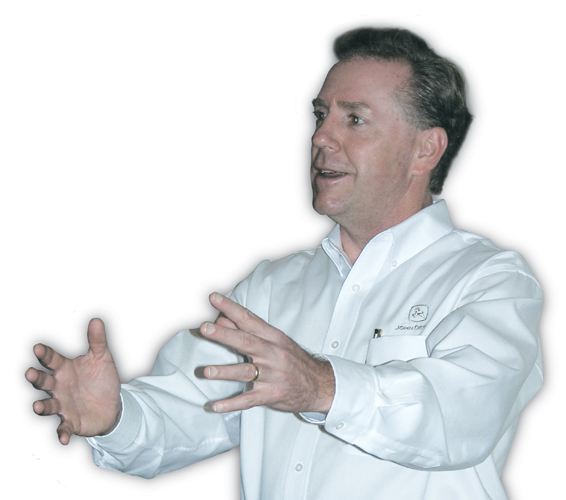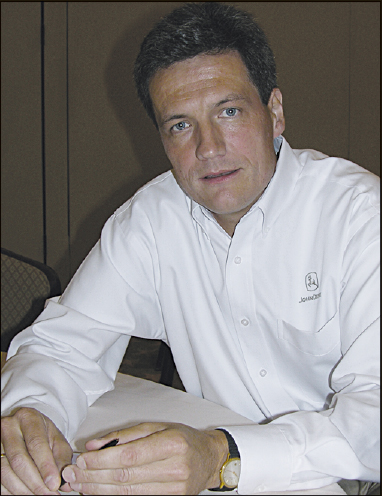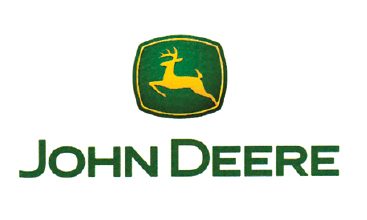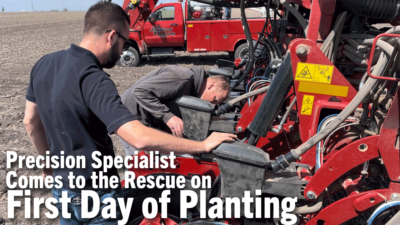Not everyone in the farm equipment community would say they follow the leader when it comes to John Deere. But few will deny that it’s part of their strategy to watch the leader.
Shortly after Deere releases its quarterly earnings recently, dozens of “breaking news” reports immedi-ately flood the Internet news sites and wire services.
For many market analyst and ag industry observers, Deere is the news.
When Deere announced in 2003 that it would begin selling lawn and garden tractors through box stores like Home Depot and Lowe’s, it sent shockwaves throughout its dealer network — and all other dealer organizations for that matter.
The perceived implication, of course, was that the ag equipment giant was bypassing its dealers. Was this the start of a bigger trend in realigning its distribution channels?
Other issues also surround Deere and its dealers. The matter of so-called “dealer purification” has also arisen as a concern.

John Lagemann
Some Deere dealers report get-ting pressured to carry only John Deere equipment and to drop other shortline brands — through direct and not-so-direct means.
This coupled with contract approval concerns, is keeping many dealers anxious these days.
This angst has carried over to other ag equipment manufacturers and their dealers as well.
Dealer Distribution
John Lagemann, John Deere vice president of sales for the U.S. and Canada, doesn’t disagree that there is movement underway to further streamline the company’s distribu-tion network.
But he emphasizes that servicing Deere customers remains its pri-mary goal.
“There’s one point that I want to make as we talk about dealer consoli-dation,” he says. “Our number of dealer locations has stayed about the same. Customer touch points have remained pretty consistent.
“What we will do is to match the channel to customer requirements. It is not anything that we intend to drive artificially. We will continue to observe our customers and trends.
“This is a relationship business. I don’t see us going to the type of organization where one dealer covers several states…” –— John Lagemann, Vice President of Sales U.S. and Canada, John Deere
“This all leads back to the compet-itive forces worldwide. Competition is a good thing. It drives cost efficien-cy and cost effectiveness. As a result, commercial ag producers continue to consolidate.”
For Lagemann, dealer consolida-tion, “in order to take advantage of economies of scale,” shouldn’t sur-prise anyone involved in the ag equipment business.
“As farms consolidate and become larger, customers become more demanding.
“As their level of service requirements increase, the need for specialization continues to increase.
“Specialization on the part of the dealer organization is becoming imperative as equipment evolves with integrated technology. This is requir-ing more staff, with special expertise, to keep the equipment in the field.
“This is driving the need for the dealer organization that has more capacity, more scale and more capa-bility to service the customer base. Our aim is to stay in synch with our customers.”
The thinking goes that as the demands for developing and main-taining an increasingly technical savvy staff increase, the pressure on equipment dealers will build to possess the resources to keep up. Naturally, those without the resources will exit the market. This leads to the logical question— how many dealers will survive the technological tumult?
“We don’t have a specific number of total dealerships in mind,” say Lagemann. “It will depend on the needs of the individual trade areas. At the end of the day, we realize that we have real people owning real busi-nesses. So you need to deal with those real people and real businesses on a one-on-one basis. And you need to analyze their capability, their future goals, their capacity. You need to make those decisions on a one-on-one basis. We pride ourselves in doing that.
“This is a relationship business. On the whole, the specialization of our dealer organizations will continue to increase. They will need the capacity to deal with multiple customer seg-ments. Our dealers will need the capability to prosper in good times and in the not-so-good times. Sustainability is becoming vital.”
Responding to questions about the “Caterpillar distribution and service model,” Lagemann reiterates that “This is a relationship business. I don’t see us going to the type of organization where one dealer covers several states.
“The sweet spot, if you will, is a dealer that has the size, scale and capacity to deal with the dynamics of the customer base. Our dealers need to be recognized on a local basis as dealing with local farm customers with a relationship approach, not an industrial approach. This is extreme-ly important to us.”
“The key is finding that sweet spot. You must foster the individual community cultures with a set of consistent business processes. Then you have the best of all worlds.”
Loyalty To Color?

Mark Von Pentz
If anyone has a stake in maintaining the consumer’s loyalty to ag equipment “color,” it is John Deere. Beyond the professional farmer, “green” equipment is immediately associated to John Deere products and, in many cases, John Deere quality.
“Loyalty to color has always been very important, especially in the North American market,” says Mark von Pentz, John Deere’s vice president of marketing. “We believe that behind loyalty is a positive owner-ship experience. So, if people are happy with what they bought and happy with the experience that the manufacturer and dealer delivered, they come back. For us it’s very important to provide a great owner-ship experience because it increases the loyalty.
“Our number one goal is to keep the customers that we have coming back and not leaving us. We’re spending a lot of energy in this area.”
Despite its legacy of farm customers loyalty to the “green,” when it comes to smaller utility and compact tractors, the fastest growing segment in ag equip-ment the past few years, Deere faces the challenge of developing and maintain-ing a new customer base who may wil pay as much attention to the “color.”
“There is much more competition in this range of tractors,” says von Pentz. “The lower horsepower end is a challenge. We’ve tended to come from the upper end of farm equipment for the professional farmer.
“We’ve expanded our compact tractor line and are stressing simpler technol-ogy, simpler operation at a lower cost. But there will be no doubt that they are John Deere tractors. They will have all of the core attributes that our long-time, loyal customers have come to expect from us. They’re not the fanciest tractors, but they share the same qualities of our bigger equipment,” says von Pentz.
Beyond the equipment itself, von Pentz knows that another big challenge in developing this new market for compact tractors will be for the dealers themselves.
“These are a different type of customer, so you need a different breed of salesperson. The traditional salesman sometimes finds it difficult to deal with the new consumer. They speak a different language and don’t always under-stand standard farm equipment terminology. It requires a different kind of salesmanship.”
He adds that it may go so far as to requiring a new and different culture with-ing the dealerships themselves. “These people want their equipment running over the weekend and they are sometimes more challenging than the profes-sional farmers. When something breaks down on Saturday, they want it running that day. Establishing color loyalty with this customer base will take some effort, but we think we’ve got an edge,” says von Pentz.
Utilizing Other Distribution Channels
With Deere’s decision to sell lawn and garden tractors direct through the box stores, some have speculated that this might use this approach with other equipment, as well.
According to Lagemann, “This the-ory is more of a myth than fact. We’ll continue to do business with inde-pendent dealers. Will we have some direct sales? Yes. We’ll have some direct sales with customers that desire central purchasing, consistent purchasing. You will always need dealers for service to meet local requirements. The future of the deal-er is quite bright.
“We’re in the second year of this arrangement and we’re extremely pleased with the strategy, because we recognize the fact that the consumer base has changed. People like to go into a big box store and buy their hardware and other yard product needs. They want to do it on Sunday afternoon or Thursday night. We rec-ognized the trend.
“What can we bring to the mar-ketplace that differentiates us?Clearly, the dealer organization is a differentiator. The dealers are involved in every pre-delivery aspect of lawn tractors. Not all deal-ers, of course. Every tractor is pre-delivered through a dealer. And they have an opportunity for all the fol-low-up parts and service business. In fact, their sales of lawn tractors have gone up because of the expo-sure and the strategy to advertise consistent pricing. The majority of our dealerships will tell you they’re generally pleased.” cause of concern for some ag equip-ment dealers. Lagemann views the web as a viable channel for limited sales and distribution of some con-sumer equipment, and sees great potential for consumer information and support.
“We offer the ability for consumers to purchase some of our lawn equip-ment online. The reason we do that is the delivery requirements are more streamlined. But it’s important to note that when we do, we offer the dealer a full margin in the delivery process. All we do is identify the transactions.
“As far selling new farm machinery on the Internet, it’s is not going to happen. But on the other hand we want to take advantage of the Internet to provide information for the purchasing decision. So the Internet is a great tool. We don’t see it as a large, complete transactional type of medium, though.”
The following “Special Report” was put together to give Farm Equipment readers the manufacturer’s perspective on these and other issues con-fronting ag machinery dealers.
How the ‘Big Four’ are Dealing with Dealer Issues
AGCO’s Dealer Network Heading for ‘Somewhere in Between’
Case IH’s Frank Anglin Brings Analytical Approach to Dealer Management








Post a comment
Report Abusive Comment